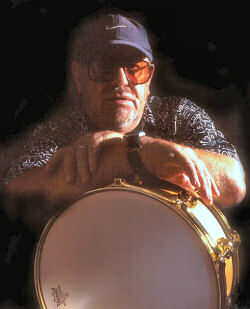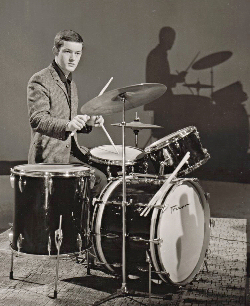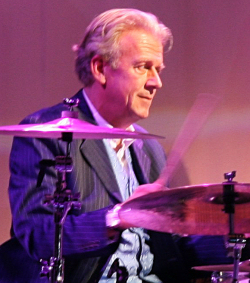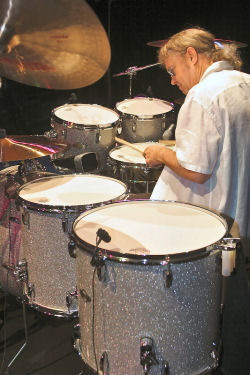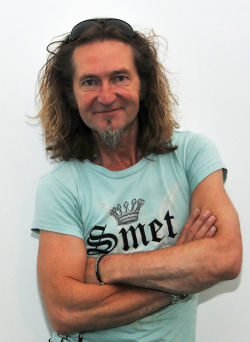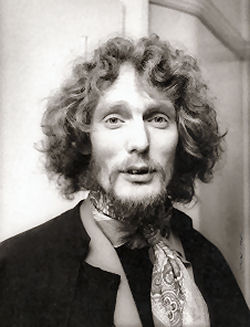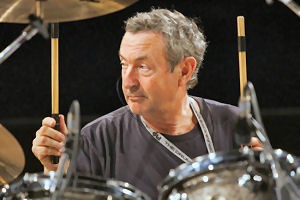
Nick Mason
You’ll be surprised to know it’s not every day I go to meet anybody who owns a £30,000,000 Ferrari 250 GTO and 40 other ‘serious’ cars, but most people may well be surprised to know he’s a drummer! [The internet can’t make its mind up on this car’s value but it’s in between 20 or 30 followed by six noughts.]
Nick Mason has been in Pink Floyd since the beginning, and depending on who you believe shows no sign of stopping! (I say ”who you believe” because while other people insist that the Floyd are definitely going out again and support bands are already booked, Nick doesn’t about it and and if anyone should…!). That said he’s probably too busy to tour because he’s doing his own thing. Our meeting took a bit of setting-up because in the three weeks or so I was negotiating he had been to America twice and was about to jet off to LA the day after we spoke.
It’s a well-documented fact that drumming is not his only vice, hence some of the world’s most expensive cars. He also produces, writes books, flies helicopters and over the phone he told me some stuff which I’m not sure I can leak yet but if you read in this about the new releases you’ll know I can!
I met him in his HQ which is not a million miles from Pentonville Prison – although this is simply coincidental. The give-away to his whereabouts is one of those light-up Ferrari signs you used to see outside dealerships like Maranellos on the A30 in Egham You have to walk down a mews alleyway to see this though, climb the metal steps to the first floor and you’re there. Nick’s enclave is an old factory/warehouse and depending on which side you look first houses a Ferrari F1 car and a Sinclair C5, with a large scale model Stuka dive bomber hanging over them from the ceiling; the other side reveals several drum kits with a twin-winged (possibly de Havilland) airliner hovering over them. There’s a two up, two down twin bass drummed olive-badged Ludwig kit painted with ‘The Great Wave’ in the style of Hokusai, a Ferrari red DW set complete with prancing horse yellow shield badges, a vintage kit with a large bass drum on a wheeled console with Chinese toms, sneeze cymbals and various traps attachments which has no identification. [Until I discovered what I’m 90% certain was an ancient Rogers wooden saddled stool behind it I thought it could be a Hawkes or possibly a Windsor.] The other item on display was (surprise! surprise!) a Flats ‘Lite’.
Downstairs there was a great deal more: evidently just about every Floyd drumkit other than the original sixties Premier and there was a Trixon Speedfire with ‘tank-turret’ nutboxes which Nick is deciding whether or not to do up.
We sat down at a large table to chat and everywhere I looked there were shelves full of scale model cars, racing helmets, steering wheels, snare drums, the odd guitar, tapes, and more books than you could shake a stick at.
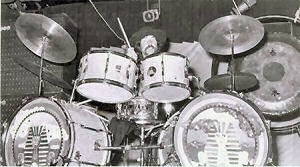 What actually got you into drumming?
What actually got you into drumming?
I think it was through a friend of my parents who played jazz piano. My mum played piano so we had a piano in the house and I think he probably gave me a pair of brushes as a kick-off. I think we had an African drum and I got just vaguely interested then and there. This was almost pre rock and roll and I think rock and roll hit about the time I was 14 or 15 and me and my friends decided we would be a band. I got money for Christmas, assembled £7.50, and took it to Archer Street where they found me a bass drum for £7.50 a Gigster I think , a pair of bongos, hi hat, snare and a pedal. There we were. I hadn’t had any lessons, never quite got round to doing lessons. This was about 1958. I would have been at school and I went to college in ‘62.
This friend of mine had already got a guitar. We started recording and did local gigs. My dad had a tape recorder as he made documentary films. He was making films about motor racing and sport doing the sound recording for them. He had a Grundig stereo so we recorded 4 numbers, which are so dreadful, I still have them! One friend decided he would be a saxophone player and went and bought a saxophone. It was totally out of tune. We hadn’t quite worked out the technical aspects of this, which has really been the story of my musical career.
So you were in a band and the 60’s arrived?
No ‘50s, with my mates round the corner, a school kids’ band. That got dropped and I arrived at college. What happened was that one of the guys in another department had written some songs and he wanted to play them to a publisher and he asked around for anyone who played. Rick, Roger and myself said: “Oh yes”. So he put together a little band to play these songs, which quite a well-known publisher wanted to hear. He thought the band was terrible, but quite liked the songs! Probably this was the catalyst because Roger does like a challenge.
So we came back, rehearsed quite a bit in a room at college that nobody used much and it wandered on from there really. Two or three different things happened to make it work. Roger and I rented a flat together from one of our year masters, Mike Leonard, who worked part time at Hornsey College. He was interested in this Hawaiian sound thing. He had a keyboard, so we played and rehearsed in the house, with him playing some of the time. This is where we started working a bit with light and sound. So then when Syd Barrett came down from Cambridge, he came to stay at the house in Stanhope Gardens and then it all began to build up, because everyone was getting slightly better at the instruments.
Were you playing progressive music?
I think everyone at that time really wanted to be an R&B band. We were probably playing quite a lot of R&B, a lot of Bo Diddley, but also contemporary hits of the period like Concrete and Clay.
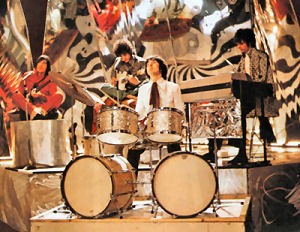 OK so at this time you weren’t thinking progressively?
OK so at this time you weren’t thinking progressively?
No, that sort of did come out of it, it was just a matter of we’d start with a song. I think eventually it was just a case very much of improvising to whatever the lights would do.
Was Ray Davies there amongst your college crowd?
Not that I remember. It would be interesting to know if he remembers. The Kinks were well ahead of us. I can absolutely remember the Kinks’ singles when I was still at college and we weren’t really playing at all.
So when was your next drum set? When you got into the band from Hornsey, what next?
It must have been a gradual move to improve the set. By the time I was at college I probably had a Premier kit and that must have stayed with me for the next three or four years. I then became an endorser for Premier and by ’69, I think, I had quite a nice double Premier kit.
What inspired you to play double bass drum?
Seeing Ginger Baker live with Cream, probably in ‘66.
You were a Premier endorser, so were they doing experimental things for you?
No, I was just supplied with a kit. I was very junior.
Are you called Pink Floyd yet?
We were sort of Pink Floyd in ‘66 I suppose.
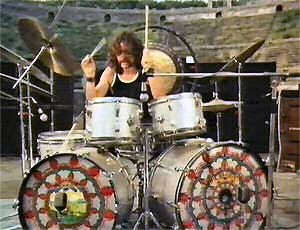 Did the band before have a name?
Did the band before have a name?
All sorts of names. The Megadeths, the Architectural Addabs, The Abdabs, and the Tea Set. There were a number of other Tea Sets, we were one of the less well known Tea Sets!
So eventually you get into the whole thing with Pink Floyd and then started the interminable drives up and down the motorways I guess?
What happened was in summer ‘66 two guys came to see us and said they’d like to manage us, they had seen us playing somewhere before. We said alright then, come back in September, which they did. They were Peter Jenner and Andrew King of Blackhill Enterprises. We had an agent, Brian Morrison and he was very close to EMI. We had a producer, Joe Boyd, who had tried to get us on to Elektra but he could see the writing on wall that he was going to be written out of it, because EMI would want one of their guys, not an Elektra producer. Basically, EMI came along and we got a record deal and signed up in early ‘67 and that’s when it all begins. So we went from doing 6 gigs in 1966 to doing 200 in 1967.
So, you now have a record deal, you’re making records and you’re touring.
We were on the road, but we very rarely stayed away, most of the time touring we drove there and back. We all lived in London and with the cost of hotels it was almost easier to drive there and back, be in the Blue Boar at 3 in the morning and everyone else would be there. The parking area was full of transits.
When did you first go to Europe?
Probably we’d do a 3 day tour of Belgium and Holland, and it was my introduction to the idea of doing a tea-time show and a late show and driving between each one. We only did a bit of that before we chucked it in.
 And America… when did that begin for you?
And America… when did that begin for you?
We did our first American tour in summer ‘67 and Syd was in a pretty weird state by then. We were late going out because of visa problems and early coming back because Syd was falling apart really. It was a short tour but it was an introduction to America and we were sort of third on the bill. We did those awful TV shows, miming.
Miming must have been a bit difficult for progressive music?
That was something we did live, but we had a record company who were looking for hit singles – so were we really.
The next tour we started doing all the events and promotions which were fantastic. It changed in ‘67 really, primarily due to the Beatles’ Sgt Pepper. It showed albums were outselling singles and everyone got involved. Record companies wanted that.
What stopped you living in America?
We always had a group policy that we would not tour for more than 3 weeks. We’d come back and spend quite a lot of time in the studio and being an EMI band that meant Abbey Road, so it wasn’t something that crossed our minds. We saw ourselves as England based.
 By this time you’ve moved to Ludwig I would guess.
By this time you’ve moved to Ludwig I would guess.
I think I’d wandered over to Ludwig by now. I think I played Ludwig without being an endorser for quite a long time. It was mainly just for that thing of seeing Ginger Baker playing and thinking that’s what I want. I think I flirted with a Gretsch for a brief period. I sold it to one of our road crew who I think has still got it.
They were not really great drums, but they did look good. We were just getting into elaborate lighting on stage, and of course they were perfect for that.
Was it the whole ethos of your father doing racing cars and being part of that that made you interested in the nuts and bolts of the vintage drum side?
I don’t think I was interested in that until the last 10 years. I think it’s something that you become more interested in later on. It’s a bit like racing drivers have no interest in old racing cars, they’re professionals, they’re only interested in what they’re working in. I really didn’t collect drums at all, but hung on to what I’d got generally. I was only looking to play newer drums because at that time there was enormous development of the hardware. From Keith Moon on, everyone suddenly wanted stronger hardware. Premier were ahead of the game in my opinion, they did a new range of stands that were much harder with better wing nuts that were stronger. This was really important, because things were a bit flimsy, certainly for this heavyweight style of drumming. I think one was always looking forward rather than looking back. The weirdest thing is some of the vintage drums are some of the drums I had for years.
Do you wish you’d kept everything you had?
Yes I do. But what I’d love is if that there [points to a kit] was still the Ludwig silver sparkle and I’d bought some plain shells to put it on. I think there’s something really nice about some of those older kits.
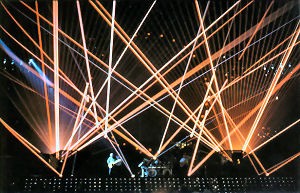 Can we talk about what you’ve been doing secretly in LA yet?
Can we talk about what you’ve been doing secretly in LA yet?
Yes. The plan is that in September we will release a whole series of records, or albums, that is an anthology of what we’ve been doing, taking let’s say Dark Side of the Moon, which consists of a boxed set, which would be Dark Side as it was originally recorded, as a CD in high definition, a 1974 version of it played live and maybe some demos. So it’s sort of the whole thing and to some extent marks, I think, not quite the end of boxed sets, but with downloading fewer people have the capacity to store records and all the lovely artwork that goes with it. So the idea is to make sure it has all the artwork with it. So we’re trying to reinvigorate the old catalogue, but add bits to it, so it’s quite interesting.
So that’s out next year?
No, the end of this year [2011]. There will also be a few other things, an introduction to Pink Floyd, a single disc, for people who don’t know very much about us. Then there will be the immersion version for people who are really interested.
Is there any possibility of vinyl?
I don’t know quite what we’ve decided so far but vinyl is of interest. We’ve managed to find ‘Wish You Were Here’ the original track. We found something I thought had been destroyed and would never ever see the light of day. While we were in the studio recording, Stefan Grappeli came to see what we were up to. Stefan ended up playing on the record and I thought we’d lost it, but we’ve found that.
That’s historically important.
So if we can put a few things like that into it’s a bit more than a re-package.
Is Storm doing your artwork?
Oh yes.
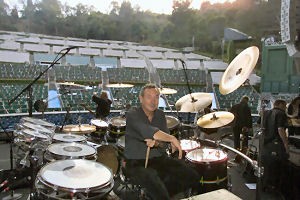 Hipgnosis was a fantastic operation.
Hipgnosis was a fantastic operation.
Hipgnosis for us, but Roger Dean for Yes.
So who are your heroes?
I think at one time all the bebop American drummers, I’ve still got lots of Art Blakey particularly. Chico Hamilton. Not so much the big band drummers. I was never a big Buddy Rich fan. Kenny Clarke, then the English school. I used to go to Ronnie Scotts with Tubby Hayes, Phil Seamen, then moved on to the rock drummers, Ginger, Keith, Mitch Mitchell, who I still think is underrated. He had this easy slightly jazzy style. In terms of working with Jimmy he was absolutely great, in many ways so much more interesting than Buddy Miles.
This could be sacrilegious but I thought Buddy [Miles] suited the latter day Hendrix.
I’m not saying that I didn’t like it, but I thought that light jazzy touch Mitch used to do just suited it so well. Buddy Miles was back to the R&B thing. .
Did you never covet that Chico Hamilton drum kit? It was a green Gretsch with gold fittings single headed toms, which is why he got that sound. I’d always wanted to interview him and he unfortunately died before the event. I met Tony Meehan at a funeral, he fell downstairs within a week or two of us trying to get it together to talk. I know his story would have been interesting. Tony was very self-effacing didn’t realise what he had done to our generation. You didn’t include him in your list.
I possibly should have included him. But, I think to some extent though it was that move in 66/67, up until then the drummer was very much at the back of the stage. In ‘67 it was so interesting what happened, they started moving the drummer up to centre front.
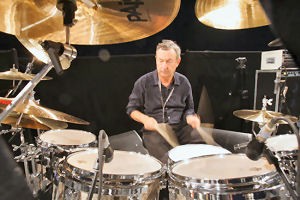 Do you think this was because we all had to play the obligatory drum solo?
Do you think this was because we all had to play the obligatory drum solo?
I don’t know, I ended up never playing drum solos. Just very briefly on one tour for one particular song, but there were other things to do.
Looking around the walls here even though you’ve collected one of something, aren’t you always looking for the next one?
You mentioned the car thing, to a large extent you can always try and upgrade to get the one you think is the right one and I am in the fortunate position of being able to do that. There’s pleasure in having exactly the right car and sometimes there’s a great deal of pleasure in building the right car and I’ve done lots and lots of car builds over the years.
Our generation was forever changing things and making bits that made life easier for us as drummers. Was that something that came naturally to you?
I’m quite interested in the engineering of drums and surprised constantly at how poor it often is – or was. I think drum engineering now is so much better in the quality of the way things are made. Also what’s interesting is the drum manufacturers have become much more interested in making those good ideas, like little clutch releases for hi hats, and something I really like, it’s a DW thing, a double hi hat where you can actually mount two pairs of cymbals.
The interesting thing about the drum industry is by and large there is nothing that hasn’t been done before.
It’s been around for thousands of years and it’s still the last acoustic instrument, pretty well. Lots and lots has been tried and modified.
I think in the sixties we put up with a lot in the way of sound – the nonsense of having to put tea towels all over the drums and completely kill any resonance. You were fortunate that with Pink Floyd you actually got away from that quite quickly, you had round-sounding drums while the rest of us were being asked to sound like cardboard boxes.
I think in recording we were still damping like mad. The tendency was to damp the drum and then put a load of echo on later. Drum manufacturers continued to build a bass drum you needed to take apart and fill with sand!
Interview Bob Henrit

